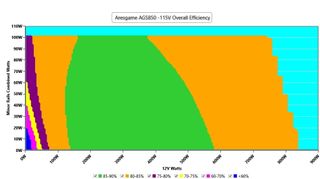Why you can trust Tom's Hardware
Protection Features
Check out our PSUs 101 article to learn more about PSU protection features.
| OCP (Cold @ 25°C) | 12V: 76.4A (109.14%), 11.803V 5V: 26.5A (132.5%), 4.843V 3.3V: 24.5A (122.5%), 3.410V 5VSB: 3.2A (128%), 4.948V |
| OCP (Hot @ 38°C) | 12V: 75.4A (107.71%), 11.484V 5V: 25.1A (125.5%), 4.869V 3.3V: 22A (110%), 3.357V 5VSB: 3.2A (128%), 4.947V |
| OPP (Cold @ 25°C) | 901.99W (107.38%) |
| OPP (Hot @ 39°C) | 898.12W (106.92%) |
| OTP | ✓ (121°C @ secondary side) |
| SCP |
12V to Earth: ✓ 5V to Earth: ✓ 3.3V to Earth: ✓ 5VSB to Earth: ✓ -12V to Earth: ✓ |
| PWR_OK | Accurate but lower than 16ms |
| NLO | ✓ |
| SIP | Surge: - Inrush: NTC Thermistor |
The OCP triggering points are low at 12V, and this is good since this rail cannot take much abuse because of the increased energy losses. OPP is set low, too. Moreover, the minor rails are conservatively set.
It is nice to see OTP in this outdated platform, but there is no surge protection. Finally, we should mention that the PSU survived all of our tough protection features tests.
DC Power Sequencing
According to Intel’s most recent Power Supply Design Guide (revision 1.4), the +12V and 5V outputs must be equal to or greater than the 3.3V rail at all times.
Unfortunately, Intel doesn't mention why it is so important to always keep the 3.3V rail's voltage lower than the levels of the other two outputs.



No problems here since the 3.3V rail is always lower than the other two. The minor rails need some time, though, to start rising to the nominal voltage levels.
Cross Load Tests
To generate the following charts, we set our loaders to auto mode through custom-made software before trying more than 25,000 possible load combinations with the +12V, 5V, and 3.3V rails. The deviations in each of the charts below are calculated by taking the nominal values of the rails (12V, 5V, and 3.3V) as point zero. The ambient temperature during testing was between 30 to 32 degrees Celsius (86 to 89.6 degrees Fahrenheit).
Load Regulation Charts




Efficiency Graph

Ripple Graphs
The lower the power supply's ripple, the more stable the system will be and less stress will also be applied to its components.




Infrared Images
We apply a half-load for 10 minutes with the PSU's top cover and cooling fan removed before taking photos with a modified Fluke Ti480 PRO camera able to deliver an IR resolution of 640x480 (307,200 pixels).




The temperatures are increased, especially on the secondary heatsink. The platform has a hard time with no active cooling.
MORE: Best Power Supplies
MORE: How We Test Power Supplies
MORE: All Power Supply Content
Current page: Protection Features, DC Power Sequencing, Cross-Load Tests and Infrared Images
Prev Page Load Regulation, Hold-Up Time, Inrush & Leakage Current, Efficiency and Noise Next Page Transient Response Tests, Timing Tests, Ripple Measurements and EMC Pre-Compliance TestingAris Mpitziopoulos is a Contributing Editor at Tom's Hardware US, covering PSUs.
-
escksu I think this review simply enforce the fact that you should always buy your PSU from reputable brands like Seasonic, Superflower etc.... For those that you have never heard of, well.....forget it.Reply -
Co BIY Thousands of reviews on Amazon for a product not sold on Amazon. I wonder if any of them are legit ?Reply
